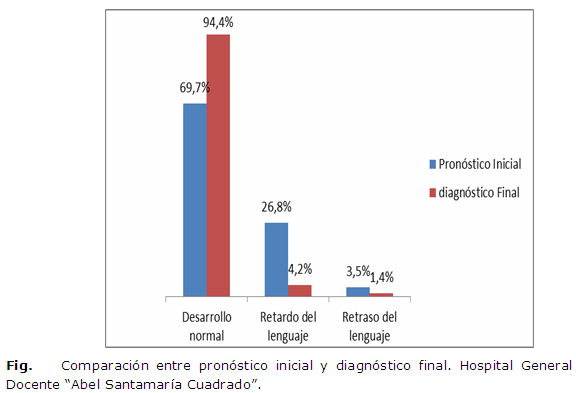Results of implementing a pre-language stimulation program in children with perinatal risk factors
Keywords:
Child language, Risk factors.Abstract
Introduction: for many, learning one's mother tongue constitutes the human being's greatest intellectual feat. It is an accumulative process, where the main features become richer.Objective: to design a stimulation program for prevention and timely treatment of language disorders in children with perinatal risk factors, so that it allows a proper development of basic elements of oral communication starting from the results of the pre-language stage evaluation. It was developed at the Abel Santamaria Cuadrado Ob-Gyn Hospital´s Neurodevelopment Service, in the period 2010-2011.
Material and method: an observational, descriptive, longitudinal, prospective study was carried out of logophoniatric medical records data processed into the statistical system InfStat 1.0. The target group consisted of 183 children and the sample comprised 142 children that conformed to the inclusion criteria.
Results: the sample presented 68 prenatal risk factors, 234 perinatal, and 150 neonatal. The association of risk factors predominated in a same child and gravity resulting from such association corresponded with the presence of moderate and mild risks for the onset of after-effects during the neurodevelopment. 94% of the children had language development in accordance with their age.
Conclusions: the study allowed effectiveness of the actions carried out by specialists and the family after the implementation of the stimulation program.
Downloads
References
1. Álvarez Lami L, Fernández Collazo L, Ferrer Sarmientos A, López Betancourt M, Capó Alonso MT, Regal Cabrera N, et al. Intervención Temprana. En: Logopedia y Foniatría. Editorial Ciencias Médicas, La Habana; 2008; 137-52.
2. Castillo L. La comunicación oral en niños con factores de riesgo perinatales. Hospital R. G. C [tesis de especialidad]. Ciudad Habana: Facultad de Ciencias Médicas Manuel Fajardo.; 2010.
3. Fernández G, Rodríguez X. Clasificación, evaluación, caracterización y diagnóstico logopédico de los trastornos del lenguaje. En: Fernández G, Rodríguez X. Logopedia. Editorial Pueblo y Educación, La Habana; 2011; 71-103.
4. Hincapie-Henao L. Trastorno específico del desarrollo del lenguaje en una población infantil colombiana.? Univ. Psychol[internet]. Aug.? 2008 [citado enero 2011]; 7(2): Disponible en: http://www.scielo.org.co/scielo.php?script=sci_arttext&pid=S1657-92672008000200019&lng=en
5. Law J, Garret Z, Nye C. Intervenciones de terapia del habla y el lenguaje para niños con retraso o trastorno primario del lenguaje. Cochrane Library. [Internet]. 2010. [citado 21 de septiembre de 2011]; 5: [Aprox. 82p.]. Disponible en: http://onlinelibrary.wiley.com/doi/10.1002/14651858.CD004110/pdf
6. Domínguez Dieppa F, Cejas Pérez G, Roca Molina MC, Millán Cruz Y. Neurodesarrollo de primeros neonatos cubanos ventilados con alta frecuencia. Rev Cubana Pediatr? [Internet]. 2009? Dic [citado? 2010? Oct? 05];? 81(4): [Aprox. 10p.]. Disponible en: http://scielo.sld.cu/scielo.php?script=sci_arttext&pid=S0034-75312009000400005&lng=es
7. Suárez E., Montero A.L., Perera R., Mestre P. El Pre-lenguaje etapa esencial del neurodesarrollo. [monografía en internet]. La Habana: INFOMED; 2009: Disponible en: http://www.sld.cu/galerias/pdf/sitios/rehabilitacion-logo/el_pre-lenguaje_etapa_esencial_en_el_neurodesarrollo.pdf [citado 11 de septiembre de 2011]
8. Moreno Guerrero A. La Estimulación Temprana. Revista digital Innovación y Experiencias Educativas. [Internet]. enero 2009 [citado5 de septiembre de 2009]; 14: [Aprox. 9p.]. Disponible en: http://www.csi-csif.es/andalucia/modules/mod_ense/revista/pdf/Numero_14/AMALIA_MORENO_1.pdf
9. Pérez Ruiz Y. La preparación de la familia en la estimulación del lenguaje en la edad temprana. Manual de orientación. Contribuciones a las Ciencias Sociales. [Internet]. noviembre 2010[citado diciembre 2011]; 10: Disponible en: http://biblioteca.utec.edu.sv/siab/virtual/elibros_internet/55797.pdf
10. Fernández G, Pons M, Carreras M, Rodríguez X. Trastornos del nivel comunicativo lenguaje: retraso del lenguaje, disfasia y afasia del desarrollo. Caracterización y atención logopédica. En: Fernández G. Logopedia. Editorial Pueblo y Educación, La Habana; 2012; 71-103
11. Rodríguez A. M. Un futuro sin barreras. Retrasos del lenguaje, Editorial Pueblo y Educación. La Habana. 2011.
12. Díaz R. E. Un futuro sin barreras. Orientaciones a los especialistas que trabajan con niños en situación de riesgo biológico, Editorial Pueblo y Educación. La Habana. 2011.

Published
How to Cite
Issue
Section
License
Authors who have publications with this journal agree to the following terms: Authors will retain their copyrights and grant the journal the right of first publication of their work, which will be publication of their work, which will be simultaneously subject to the Creative Commons Attribution License (CC-BY-NC 4.0) that allows third parties to share the work as long as its author and first publication in this journal are indicated.
Authors may adopt other non-exclusive license agreements for distribution of the published version of the work (e.g.: deposit it in an institutional telematic archive or publish it in a volume). Likewise, and according to the recommendations of the Medical Sciences Editorial (ECIMED), authors must declare in each article their contribution according to the CRediT taxonomy (contributor roles). This taxonomy includes 14 roles, which can be used to represent the tasks typically performed by contributors in scientific academic production. It should be consulted in monograph) whenever initial publication in this journal is indicated. Authors are allowed and encouraged to disseminate their work through the Internet (e.g., in institutional telematic archives or on their web page) before and during the submission process, which may produce interesting exchanges and increase citations of the published work. (See The effect of open access). https://casrai.org/credit/


